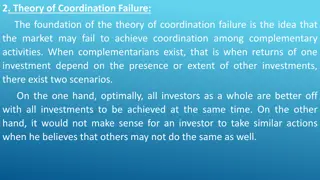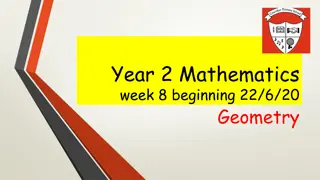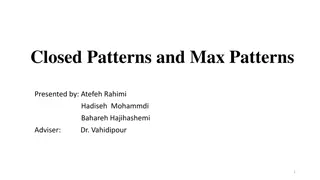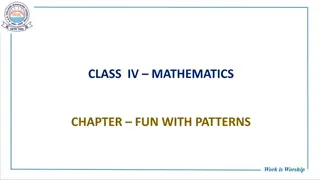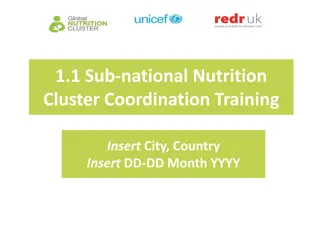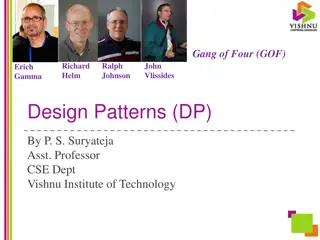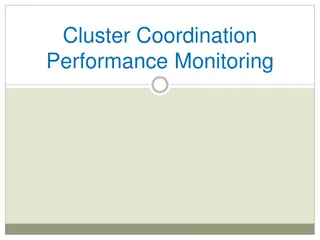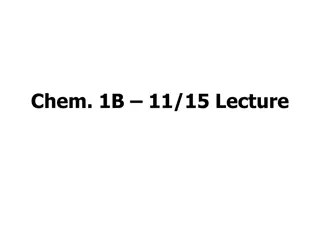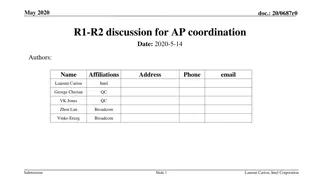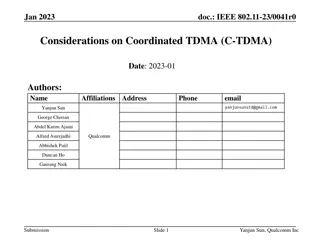COORDINATION PATTERNS
Coordination patterns play a crucial role in designing concurrent code, ensuring smooth operation and efficient performance. They help in managing interactions between threads or processes, preventing malfunctions and performance drops. Examples like producer-consumer pattern and bounded buffers illustrate the importance of coordination patterns in complex, threaded programs.
Download Presentation

Please find below an Image/Link to download the presentation.
The content on the website is provided AS IS for your information and personal use only. It may not be sold, licensed, or shared on other websites without obtaining consent from the author.If you encounter any issues during the download, it is possible that the publisher has removed the file from their server.
You are allowed to download the files provided on this website for personal or commercial use, subject to the condition that they are used lawfully. All files are the property of their respective owners.
The content on the website is provided AS IS for your information and personal use only. It may not be sold, licensed, or shared on other websites without obtaining consent from the author.
E N D
Presentation Transcript
Professor Ken Birman CS4414 Lecture 18 COORDINATION PATTERNS CORNELL CS4414 - SPRING 2023 1
IDEA MAP FOR TODAY The monitor pattern in C++ Reminder: Thread Concept Problems monitors solve (and problems they don t solve) Lightweight vs. Heavyweight Deadlocks and Livelocks Thread context C++ mutex objects. Atomic data types. Additional Coordination Patterns Today we focus on other patterns for coordinating threads or entire processes. CORNELL CS4414 - SPRING 2023 2
WITHOUT COORDINATION, MANY SYSTEMS MALFUNCTION Performance can drop unexpectedly Overheads may soar A coordination pattern is a visual or intellectual tool that we use when designing concurrent code, whether using threads or processes. It inspires a design that works well. CORNELL CS4414 - SPRING 2023 3
WHAT IS A COORDINATION PATTERN? Producers Think about producer-consumer (cupcakes and kids). The producer pauses if the display case is full The consumers wait if we run out while a batch is baking Bounded buffer Consumers This is an example of a coordination pattern. CORNELL CS4414 - SPRING 2023 4
PRODUCER CONSUMER PATTERN Producer thread(s) Consumer thread(s) Bounded Buffer CORNELL CS4414 - SPRING 2023 5
ANALOGY: SOFTWARE DESIGN PATTERNS Motivation: Early object-oriented programming approaches had a very flat perspective on programs: We had objects, including data structures. Threads operated on those objects. Developers felt that it was hard to capture higher-level system structures and behaviors by just designing some class. CORNELL CS4414 - SPRING 2023 6
MODULARITY FOR COMPLEX, THREADED PROGRAMS With larger programs, we invariably need to break the overall system up and think of it in terms of subsystems. Each of these may have its own classes, its own threads, and its own internal patterns of coordination and behavior. When a single system has many such modules side by side, the patterns used shape the quality of the resulting application CORNELL CS4414 - SPRING 2023 7
SOME EXAMPLES. Main thread File opener Word-count workers Fast-wc had a main thread, a thread for opening files (a form of module), a set of concurrent word counters, logic to merge the resulting std::map trees, and finally logic for sorting and printing the output. We can think of this structure in a modular way. In fact, we need to think of it in a modular way to understand it! CORNELL CS4414 - SPRING 2023 8
WHAT EXACTLY DOES MODULAR MEAN? A modular way of describing a system breaks it down into large chunks that may have complex implementations, but that offer simple abstraction barriers to one-another. The operating system has many modules: the file system, the device drivers, the process management system, the clock system Each involves a substantial but separate chunk of code. CORNELL CS4414 - SPRING 2023 9
MORE EXAMPLES Databases are integrated into modern systems (think of LINQ!) Each database is a complex services and internally, deals with concurrent users, scaling, prefetching, locking to ensure correctness (a topic we will revisit in future lectures), fault- tolerance Yet the user doesn t see any of this complexity and is even unaware of the other concurrent users. CORNELL CS4414 - SPRING 2023 10
MORE EXAMPLES Web servers at companies like Amazon, Facebook, Netflix The Linux kernel The C++ compiler CORNELL CS4414 - SPRING 2023 11
SOFTWARE DESIGN PATTERNS There is some similarity between synchronization patterns and software design patterns . Basic idea: Problems that often arise in object oriented programs, and effective, standard ways of solving them. CORNELL CS4414 - SPRING 2023 12
EXAMPLE: THE OBJECT VISITOR PATTERN The visitor pattern associates virtual functions with existing classes. The class offers a static method that permits the caller to provide an object (a functor ) that implements this function interface. The base class keeps a list of visitors, and will call those functions when objects of the base-class type are created or modified. With this you can build new logic that takes some action that was not already part of the design when the base class was created! CORNELL CS4414 - SPRING 2023 13
REMINDER: INTERFACES In a C++ .hpp file, one normally puts the declarations of classes and templates, but the bodies are often in a .cpp file. A virtual class is one that has a .hpp file defining it, but no implementations. An interface is a standardized virtual class. A C++ class can implement an interface, and then you can pass class objects to any method that accepts the interface type. CORNELL CS4414 - SPRING 2023 14
EXAMPLE OF HOW YOU MIGHT USE VISITOR Suppose that you wanted to monitor a collection of files. With this visitor pattern, you attach a notifier to the directory those files live in. The file system supports this form of visitation but doesn t know who will use it in the future. Each time a file changes, your program receives a notification. CORNELL CS4414 - SPRING 2023 15
HOW TO THINK ABOUT THE VISITOR IDEA Consider a restaurant pager. You place a take-out order but then can go outside or wander around. When your food is ready the pager wakes up and this notifies you. No need for the food preparer to do anything more. CORNELL CS4414 - SPRING 2023 16
VISITOR PATTERN USE CASES The visitor pattern is common with file systems: it allows an application with files open to refresh if a change occurs. It is also useful with GUI displays. If something changes, the application can refresh or even recompute its layout. CORNELL CS4414 - SPRING 2023 17
KEY ELEMENTS OF THIS PATTERN The visitor is an object in some application written after the service was created. The application object derives from (implements) the notification interface. The service doesn t know what objects will be using it, but can use the interface class to notify future customers . The visitor interface is a fully virtual class with an event notification method. The service will treat application objects as instances of visitor objects CORNELL CS4414 - SPRING 2023 18
KEY ELEMENTS OF THIS PATTERN Visitor Interface is a base class The application class derives from (implements) the base class, but extends it with other application functionality CORNELL CS4414 - SPRING 2023 19
WHY GIVE THIS PATTERN A SPECIAL NAME AND THINK OF IT AS A STANDARD? Visitor is a well known pattern and even taught in courses on software engineering. We sometimes teach it in CS2110 So anyone who sees a comment about it, and then sees the Watch method, knows immediately what this is and how to use it. In effect, it is a standard way to do refresh notifications CORNELL CS4414 - SPRING 2023 20
WHY IS THIS SUCH A BIG DEAL? By allowing modules to standardize the way that they coordinate and interact, patterns bring a uniform way to create bigger systems from modular components. The monitored module doesn t know who will monitor it, but does know how to notify those future watchers. The watchers simply need to implement the required interface CORNELL CS4414 - SPRING 2023 21
FACTORY PATTERN Another example from software engineering. A factory is a method that will create some class of objects on behalf of a caller that doesn t know anything about the class. Basically, it does an allocation and calls a constructor, and then returns a pointer to the new object. CORNELL CS4414 - SPRING 2023 22
WHY A FACTORY IS USEFUL If module A has code that explicitly creates an object of type Foo, C++ can type check the code at compile time. But if module B wants to register class Foo so that A can create Foo objects, A might be compiled separately from B. The factory pattern enables B to do this. A requires a factory interface (for any kind of object), and B registers a Foo factory CORNELL CS4414 - SPRING 2023 23
WHY A FACTORY IS USEFUL without the factory, this same coordination is quite hard! By allowing B to offer a factory that creates widget objects A has a way to ask B to create new B objects (derived from widget) and yet A doesn t even know the definition of class B. B simply needs to implement the factory interface CORNELL CS4414 - SPRING 2023 24
TEMPLATES ARE OFTEN USED TO IMPLEMENT MODERN C++ DESIGN PATTERNS A template can instantiate standard logic using some new type that the user supplies. So this is a second and powerful option that doesn t require virtual functions and upcalls. For example, we could do this for our bounded buffer. It would allow you to create a bounded buffer for any kind of object. The bounded buffer pattern is valid no matter what objects it holds. CORNELL CS4414 - SPRING 2023 25
SUMMARY: WHY STANDARD SOFTWARE ENGINEERING PATTERNS HELP They address the needs of larger, more modular systems They are familiar and have standard structures. Developers who have never met still can quickly understand them. They express functionality we often find valuable. If many systems use similar techniques to solve similar problems, we can create best-practice standards. CORNELL CS4414 - SPRING 2023 26
SYNCHRONIZATION PATTERNS These are patterns that stretch across threads or even between processes. They can even be used in computer networks, where the processes are on different machines! Producer consumer is a synchronization pattern. CORNELL CS4414 - SPRING 2023 27
SYNCHRONIZATION PATTERNS Leader / workers is a second widely valuable synchronization pattern. In this pattern, some thread is created to play the leader role. A set of workers will perform tasks on its behalf. CORNELL CS4414 - SPRING 2023 28
LEADER / WORKERS PATTERN Leader thread Worker threads Tasks to be performed ( peel these potatoes ) CORNELL CS4414 - SPRING 2023 29
LEADER / WORKERS PATTERN Leader thread Worker threads Tasks to be performed ( peel these potatoes ) CORNELL CS4414 - SPRING 2023 30
LEADER / WORKERS PATTERN Leader thread Worker threads Bag is empty? Workers terminate (threads exit) CORNELL CS4414 - SPRING 2023 31
LEADER / WORKERS PATTERN Word-to-do queue We need a way to implement the bag of work. One can pass arguments to the threads, but this is very rigid. If we have lots of tasks, it may be better to be flexible. So the bag of work will be some form of queue. You ll need to protect it with locking! (Why?) CORNELL CS4414 - SPRING 2023 32
POOL OF TASKS A std::list! One option is to just fill a std::list with tasks to be performed, using a task description object . Then launch threads. The list has a front and a back, which can be useful if the task order matters. Some versions support priorities (a priority queue ). It is easy to test to see if the list is empty. CORNELL CS4414 - SPRING 2023 33
DYNAMIC TASK POOLS Permits the leader to add tasks while the workers are running. The workers each remove a task from the pool, execute it, and then when finished, loop back and remove the next task. They may even use a second std::list to send results back to the leader! C++ calls this a promise pattern, supported by a std::promise library! But we can t use empty to signal that we are finished (why?). So, the leader explicitly pushes some form of special objects that say job done at the end of the task pool. As workers see these, they exit. CORNELL CS4414 - SPRING 2023 34
EXAMPLE: LOGISTIC REGRESSION In AI, it is common to have a parameter server that creates a model, and a set of workers that work to train the model from examples. Later we will use the model as a classifer. Worker takes the current model plus some data files, computes a gradient, and passes this to the parameter server (the leader) Parameter server consumes the gradients, improves the model, then assigns a new task to the worker. Terminates when the model has converged. CORNELL CS4414 - SPRING 2023 35
BARRIER SYNCHRONIZATION In this pattern, we have a set of threads (perhaps, the workers from our logistic regression example). We use this pattern if we want all our threads to finish task A before any starts on task B. For this, we use a barrier. CORNELL CS4414 - SPRING 2023 36
BUILDING A BARRIER We normally use the monitor pattern. The threads all call barrier_wait . This method uses a bool array to track which threads are ready, initialized to all false. When all are ready, the thread that notices this issues notify_all to wake the others up. They wake up nearly simultaneously. CORNELL CS4414 - SPRING 2023 37
Worker threads BUILDING A BARRIER Time Phase one Example: A computation with distinct phases or epochs. After phase one, all workers must wait until phase two starts. CORNELL CS4414 - SPRING 2023 38
Worker threads BUILDING A BARRIER Phase one Time Example: A computation with distinct phases or epochs. 2 Done 1 Done 3 Done Barrier All are done! Phase two can start After phase one, all workers must wait until phase two starts. CORNELL CS4414 - SPRING 2023 39
Worker threads BUILDING A BARRIER Phase one Time Example: A computation with distinct phases or epochs. Barrier After phase one, all workers must wait until phase two starts. Phase two CORNELL CS4414 - SPRING 2023 40
ORDERED MULTICAST PATTERN This is a one-to-many pattern. Suppose some event occurs. A sender thread needs every worker to see an object describing the event, so it puts that object on every worker s work queue. The pattern permits multiple senders: A sender locks all of the work queues, then emplaces the request, then unlocks. Thus all workers see the same ordering of requests. CORNELL CS4414 - SPRING 2023 41
ORDERED MULTICAST PATTERN Sender thread(s) Worker threads Event A CORNELL CS4414 - SPRING 2023 42
ORDERED MULTICAST PATTERN Sender thread(s) Worker threads Event A Event B Race condition: Danger is that one thread could see B before A, but others see A before B. CORNELL CS4414 - SPRING 2023 43
ORDERED MULTICAST PATTERN Sender thread(s) Worker threads Event A Event B Race condition: Danger is that one thread could see B before A, but others see A before B. CORNELL CS4414 - SPRING 2023 44
ORDERED MULTICAST PATTERN Sender thread(s) Worker threads Event A Event B An ordered multicast pattern implements a barrier that protects us against ordering inconsistencies. There are many ways to build the barrier. The pattern focuses on the behavior, not the implementation. CORNELL CS4414 - SPRING 2023 45
ORDERED MULTICAST WITH REPLIES In this model, we start with an ordered multicast, but then the leader for a given request awaits replies by supplying a reply queue. Often, this uses a std::future in C++: a kind of object that will have its value filled in later . The leader makes n requests, then collects n corresponding replies. CORNELL CS4414 - SPRING 2023 46
ORDERED MULTICAST PATTERN Sender thread(s) Worker threads Event A Event B With replies, workers can send results back to the sender threads. CORNELL CS4414 - SPRING 2023 47
ALL-REDUCE PATTERN: IMPORTANT IN ML. This pattern focuses on (key,value) pairs. It assumes that there is a large (key,value) data set divided so that worker k has the k th shard of the data set. For example, with integer keys, perhaps (key % n) == k With arbitrary objects, you can use the built-in C++ hash method. CORNELL CS4414 - SPRING 2023 48
ALL-REDUCE PATTERN: SHARDED DATA SET Leader Worker threads Shard C Shard A Shard B CORNELL CS4414 - SPRING 2023 49
ALL-REDUCE: MAP STEP The leader maps some task over the n workers. This can be done in any way that makes sense for the application. Each worker performs its share of the work by applying the requested function to the data in its shard. When finished, each worker will have a list of new (key,value) pairs as its share of the result. CORNELL CS4414 - SPRING 2023 50
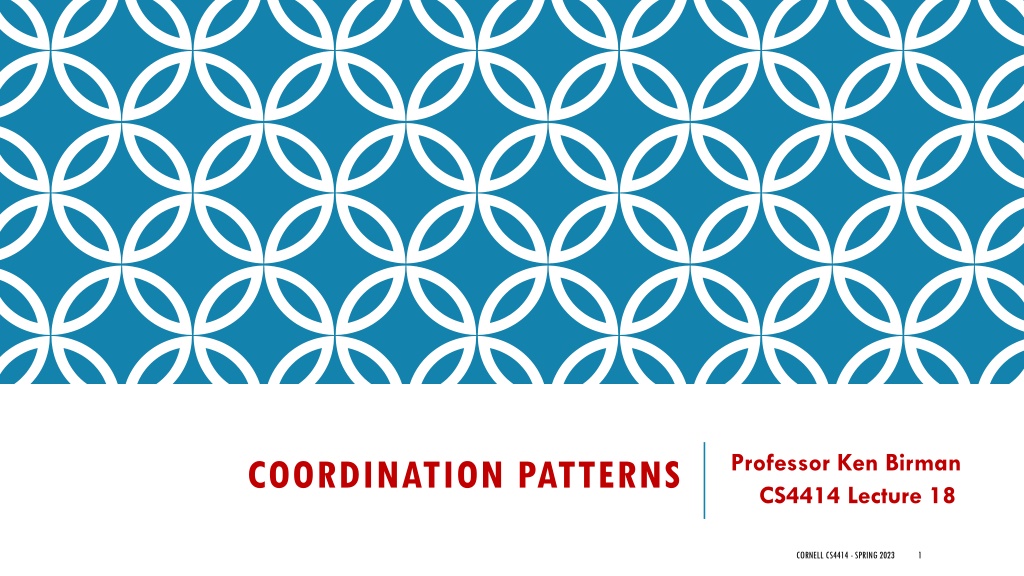
 undefined
undefined
